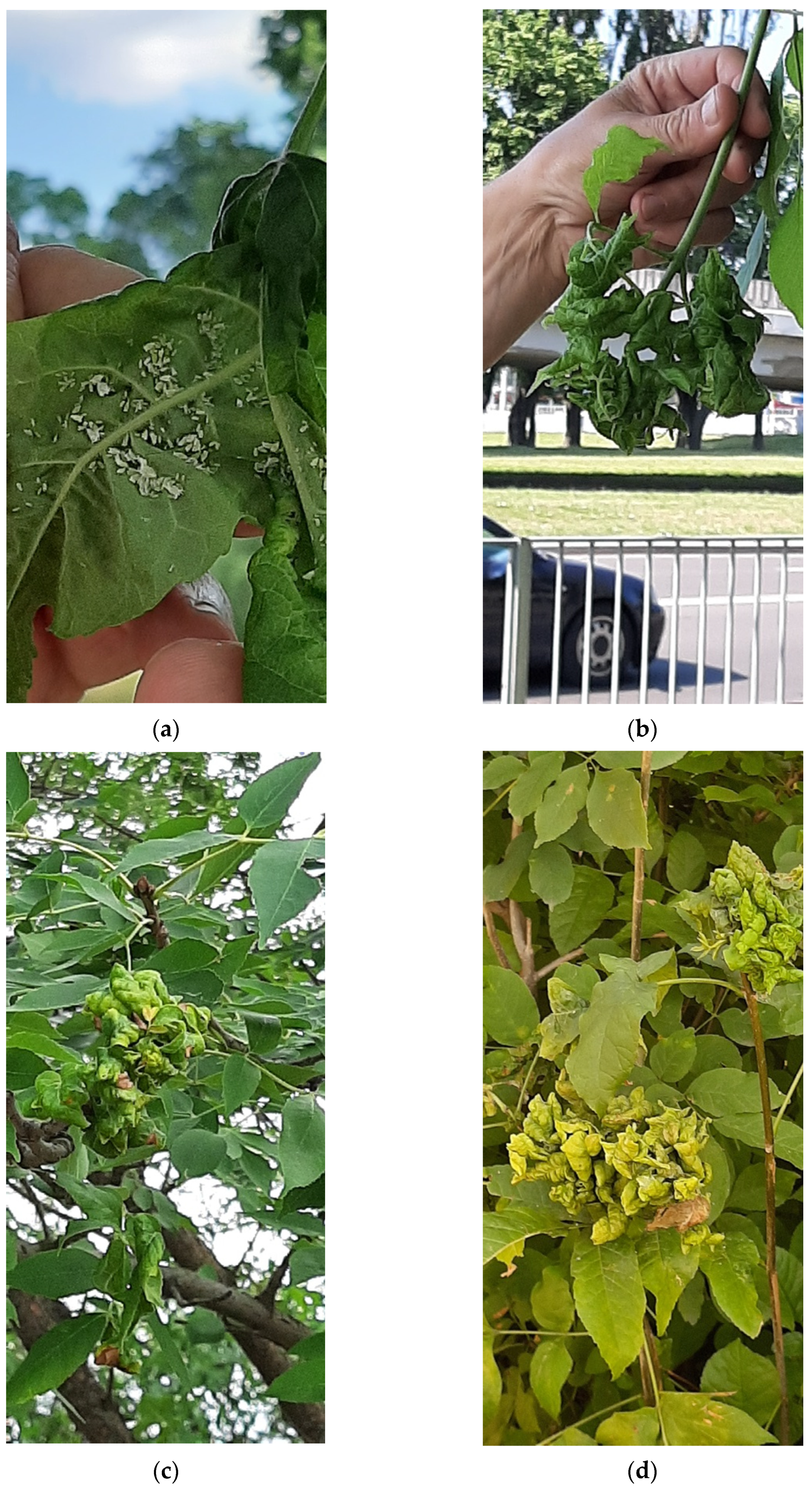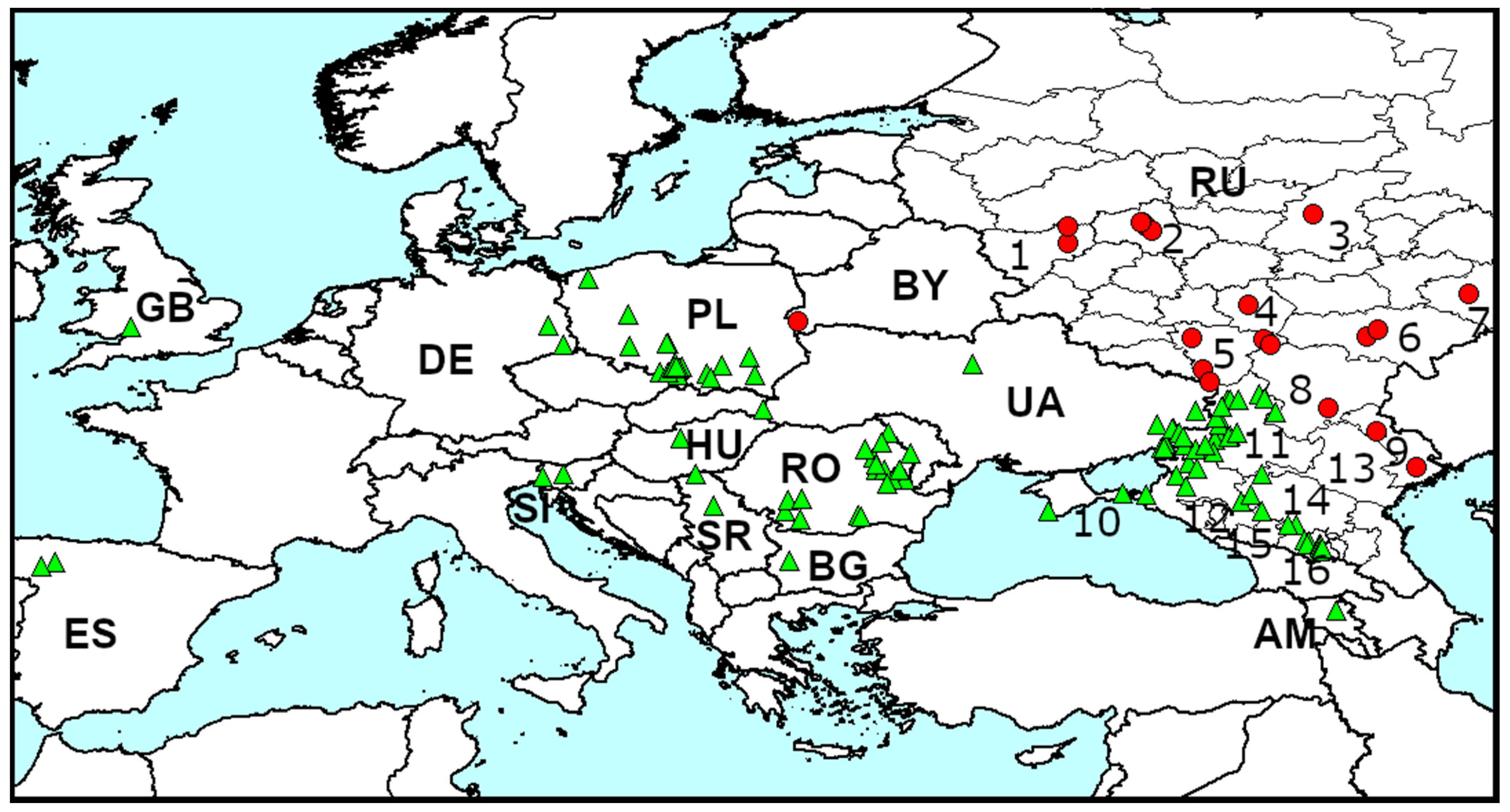Alien Pests Can Spread Quickly: Wooly Ash Aphid Prociphilus fraxinifolii (Hemiptera: Eriosomatidae) Has Occupied Europe in 18 Years
Abstract
1. Introduction
2. Materials and Methods
2.1. Collection
2.2. Identification
3. Results
4. Discussion
4.1. General Distribution in Europe
4.2. Host Plants and Ecological Impact
5. Conclusions
Author Contributions
Funding
Data Availability Statement
Acknowledgments
Conflicts of Interest
References
- Seebens, H.; Blackburn, T.M.; Hulme, P.E.; van Kleunen, M.; Liebhold, A.M.; Orlova-Bienkowskaja, M.; Pyšek, P.; Schindler, S.; Essl, F. Around the world in 500 years: Inter-regional spread of alien species over recent centuries. Glob. Ecol. Biogeogr. 2021. [Google Scholar] [CrossRef]
- Roques, A. Taxonomy, time and geographic patterns. Alain Roques. Taxonomy, time and geographic patterns. Chapter 2. Alien terrestrial arthropods of Europe. BioRisk 2010, 4, 11–26. [Google Scholar] [CrossRef][Green Version]
- Hałaj, R.; Osiadacz, B. Woolly ash aphid—is the alien bug posing a threat to European ash trees? —A review. Plant Protect. Sci. 2017, 53, 127–133. [Google Scholar] [CrossRef]
- Remaudière, G.; Ripka, G. Arrivée en Europe (Budapest, Hongrie) du puceron des frenes américains, Prociphilus (Meliarhizophagus) fraxinifolii (Hemiptera, Aphididae, Eriosomatinae, Pemphigini). Rev. Française D’entomologie 2003, 25, 152. [Google Scholar]
- Chumak, V.O.; Zhuravlev, V.V.; Migal, A.V.; Galats, V.V. New invasive species of Aphidinea in the Ukraine. Ukr. Entomofaunistyka 2016, 7, 97. (In Ukrainian) [Google Scholar]
- Petrović-Obradović, O.; Tomanović, Ž.; Poljaković-Pajnik, L.; Vučetić, A. An invasive species of aphid, Prociphilus fraxinifolii (Hemiptera, Aphididae, Eriosomatinae), found in Serbia. Arch. Biol. Sci. 2007, 59, 9–10. [Google Scholar] [CrossRef]
- Trenchev, G.; Trencheva, K. Prociphilus fraxinifolii Riley (Hemiptera, Aphididae, Eriosomatinae) a species new to the Bulgarian fauna. Sustain. For. 2009, 59, 60–79. [Google Scholar]
- Baker, E.A.; Martin, J.H. Prociphilus fraxinifolii (Hemiptera: Aphididae), a species new to Britain. Br. J. Entomol. Nat. Hist. 2011, 24, 221–223. [Google Scholar]
- Pérez Hidalgo, N.; Mier Durante, M.P. First record of Prociphilus (Meliarhizophagus) fraxinifolii (Riley) [Hemiptera: Aphididae] in the Iberian Peninsula. EPPO Bull. 2012, 42, 142–145. [Google Scholar] [CrossRef]
- Hałaj, R.; Osiadacz, B.; Poljaković-Pajnik, L. Górny Śląsk-polski przyczółek zdobyty przez obcą mszycę Prociphilus (Meliarhizophagus) fraxinifolii (Riley, 1879). Acta Entomol. Sil. 2016, 24, 1–9. [Google Scholar]
- Seljak, G. New alien phytophagous insect species to the fauna of Slovenia. Acta Entomol. Slov. 2017, 25, 141–158. [Google Scholar]
- Bieńkowski, A.O.; Orlova-Bienkowskaja, M.J. Establishment of the new alien pest wooly ash aphid, Prociphilus (Meliarhizophagus) fraxinifolii (Riley, 1979) in European Russia. Balt. For. 2018, 24, 185–188. [Google Scholar]
- Olenici, N.; Blaga, T.; Tomescu, R.; Gogu, I.; Țilea, G. Cinci specii de insecte forestiere invazive noi în partea de nord-est a României. Bucov. For. 2018, 18, 119–135. [Google Scholar] [CrossRef]
- Nețoiu, C.; Tomescu, R.; Olenici, N.; Buzatu, A.; Bălăcenoiu, F.; Iliescu, O. The invazive insect species in the Oltenia region (Romania). Oltenia. Studii și comunicări. Muz. Olten. Craiova 2018, 34, 111–123. [Google Scholar]
- Gubin, A.I. Four invasive alien phytophagous insects new to Armenia. Phytoparasitica 2021, 49, 163–166. [Google Scholar] [CrossRef]
- Volkovitsh, M.G.; Bieńkowski, A.O.; Orlova-Bienkowskaja, M.J. Emerald ash borer approaches the borders of the European union and Kazakhstan and is confirmed to infest European ash. Forests 2021, 12, 691. [Google Scholar] [CrossRef]
- Blackman, R.L.; Eastop, V.F. Aphids on the World’s Plants. An online Identification and Information Guide. 2016. Available online: http://www.aphidsonworldsplants.info (accessed on 6 July 2021).
- Martynov, V.V.; Nikulina, T.V. Modern distribution of the north American ash aphid Prociphilus (Meliarhizophagus) fraxinifolii (Riley, 1979) (Hemiptera: Aphididae: Eriosomatinae) in Southern Russia. In Proceedings of the 22nd International Scientific Conference Biological Diversity of the Caucasus and the South of Russia, Grozny, Russia, 4–6 November 2020; pp. 324–327. [Google Scholar]
- Martynov, V.V.; Nikulina, T.V. Prociphilus (Meliarhizophagus) fraxinifolii (Riley, 1979) (Hemiptera: Aphididae: Eriosomatinae) —A new invasive North American aphid species in the Donbass. In Proceedings of the Current Problems and Prospects of Integrated Plant Protection, International Scientific-Practical Conference of Young Scientists and Specialists, Dedicated to the 70th Anniversary of the Institute of Plant Protection of NAAS of Ukraine, Kyiv, Ukraine, 7–9 November 2016; pp. 53–55. [Google Scholar]
- Martynov, V.V.; Nikulina, T.V.; Shokhin, I.V.; Terskov, E.N. Contributions to the fauna of invasive insects of Ciscaucasia. Field Biol. J. 2020, 2, 99–122. [Google Scholar] [CrossRef]
- Balacenoiu, F.; Buzatu, A.; Dragoș, T.O.; Alexandru, M.A.; Nețoiu, C. Occurrence of invasive insects on woody plants in the main green areas from Bucharest city. Not. Bot. Horti Agrobot. Cluj-Napoca 2020, 48, 1649–1666. [Google Scholar] [CrossRef]
- Martynov, V.V.; Nikulina, T.V.; Shokhin, I.V. Modern distribution of invasive dendrophilic insects in the Rostov region. Subtrop. Ornam. Hortic. 2017, 63, 175–182. [Google Scholar]
- Hijmans, R.J.; Guarino, L.; Cruz, M.; Rojas, E. Computer tools for spatial analysis of plant genetic resources data: 1. DIVA-GIS. Plant. Gen. Res. Newsl. 2001, 127, 15–19. [Google Scholar]
- Buga, S.V.; Zhorov, D.G.; Leshchinskaya, N.V.; Stekolshchikov, A.V. Aphids of the family Eriosomatidae (Insecta: Homoptera) in Belarus. Zoosyst. Ross. 2016, 25, 226–232. [Google Scholar] [CrossRef]
- Siegert, N.W.; McCullough, D.G.; Liebhold, A.M.; Telewski, F.W. Dendrochronological reconstruction of the epicentre and early spread of emerald ash borer in North America. Divers. Distrib. 2014, 20, 847–858. [Google Scholar] [CrossRef]
- EPPO Global Database. Available online: https://gd.eppo.int/taxon/PROCFX (accessed on 2 July 2021).
- GBIF.org. GBIF Occurrence Download. Available online: https://doi.org/10.15468/dl.5fetzgji (accessed on 6 July 2021).
- European Alien Species Information Network. Available online: https://easin.jrc.ec.europa.eu/spexplorer/search/searchpaged (accessed on 2 July 2021).
- Orlova-Bienkowskaja, M.J.; Drogvalenko, A.N.; Zabaluev, I.A.; Sazhnev, A.S.; Peregudova, E.Y.; Mazurov, S.G.; Komarov, E.V.; Struchaev, V.V.; Martynov, V.V.; Nikulina, T.V.; et al. Current range of Agrilus planipennis fairmaire, an alien pest of ash trees, in European Russia and Ukraine. Ann. For. Sci. 2020, 77, 1–14. [Google Scholar] [CrossRef]
- Orlova-Bienkowskaja, M.J.; Bieńkowski, A.O. Modeling long-distance dispersal of emerald ash borer in European Russia and prognosis of spread of this pest to neighboring countries within next 5 years. Ecol. Evol. 2018, 8, 9295–9304. [Google Scholar] [CrossRef] [PubMed]
- Orlova-Bienkowskaja, M.J. Ashes in Europe are in danger: The invasive range of Agrilus planipennis in European Russia is expanding. Biol. Invasions 2014, 16, 1345–1349. [Google Scholar] [CrossRef]



| Country/ Region | Locality | Number of Examined F. pennsylvanica Trees and Kind of Planting 2 | Number of Examined F. excelsior Trees and Kind of Planting | Number of Infested F. pennsylvanica Trees | Date of Survey |
|---|---|---|---|---|---|
| Belarus | |||||
| Brest | Brest | >100 U | 0 | 3 | 19 June 2021 |
| Russia | |||||
| Astrakhan | Astrakhan City | >100 U | 0 | 2 | 11 May 2021 |
| Astrakhan | Nikolskoe | >50 R | 0 | 2 | 13 August 2020 |
| Astrakhan | Astrakhanskaya Fishka | >100 F | 0 | 1 | 15 May 2021 |
| Moscow | Zelenograd | >500 U | 20 U | >20 | July and August 2020 and July 2021 |
| Moscow | Alabushevo | > 50 R | 0 | 2 | 8 August 2019 |
| Moscow | Moscow City | >100 U | 0 | 3 | 28 July 2020 |
| Nizhny Novgorod | Nizhny Novgorod City | >100 U | >100 F | 10 | 19 August 2020 |
| Samara | Samara City | >100 U | 0 | 1 | 16 August 2020 |
| Saratov | Saratov City | >100 U | 0 | 5 | 10 August 2020 |
| Saratov | Usovka Island | >100 F | 0 | 3 | 15 August 2020 |
| Smolensk | Vyazma | 107 U | 67 U | 3 | 3 August 2019 |
| Smolensk | Sychevka | 32 U | 0 | 1 | 5 August 2019 |
| Tambov 1 | Tambov City | >100 U | 0 | 1 | 17 August 2020 |
| Volgograd | Volgograd City | >100 U | 0 | 2 | 11 August 2020 |
| Voronezh | Borisoglebsk | 24 U | 21 U | 1 | 12 August 2019 |
| Voronezh | Vorona River valley | >100 F | >500 F | 2 | 12 August 2019 |
| Voronezh | Povorino | >100 U | 0 | 12 | 13 August 2019 |
| Voronezh | Rossosh | >100 P | 1P | >20 | 13 August 2019 |
| Voronezh | Kantemirovka | >150 U | 0 | >50 | 14 August 2019 |
| Voronezh | Voronezh City | >500 U | >500 F, U | 5 | July and August 2021 |
Publisher’s Note: MDPI stays neutral with regard to jurisdictional claims in published maps and institutional affiliations. |
© 2021 by the authors. Licensee MDPI, Basel, Switzerland. This article is an open access article distributed under the terms and conditions of the Creative Commons Attribution (CC BY) license (https://creativecommons.org/licenses/by/4.0/).
Share and Cite
Orlova-Bienkowskaja, M.J.; Bieńkowski, A.O. Alien Pests Can Spread Quickly: Wooly Ash Aphid Prociphilus fraxinifolii (Hemiptera: Eriosomatidae) Has Occupied Europe in 18 Years. Forests 2021, 12, 1176. https://doi.org/10.3390/f12091176
Orlova-Bienkowskaja MJ, Bieńkowski AO. Alien Pests Can Spread Quickly: Wooly Ash Aphid Prociphilus fraxinifolii (Hemiptera: Eriosomatidae) Has Occupied Europe in 18 Years. Forests. 2021; 12(9):1176. https://doi.org/10.3390/f12091176
Chicago/Turabian StyleOrlova-Bienkowskaja, Marina J., and Andrzej O. Bieńkowski. 2021. "Alien Pests Can Spread Quickly: Wooly Ash Aphid Prociphilus fraxinifolii (Hemiptera: Eriosomatidae) Has Occupied Europe in 18 Years" Forests 12, no. 9: 1176. https://doi.org/10.3390/f12091176
APA StyleOrlova-Bienkowskaja, M. J., & Bieńkowski, A. O. (2021). Alien Pests Can Spread Quickly: Wooly Ash Aphid Prociphilus fraxinifolii (Hemiptera: Eriosomatidae) Has Occupied Europe in 18 Years. Forests, 12(9), 1176. https://doi.org/10.3390/f12091176






